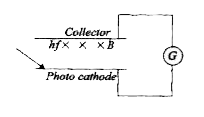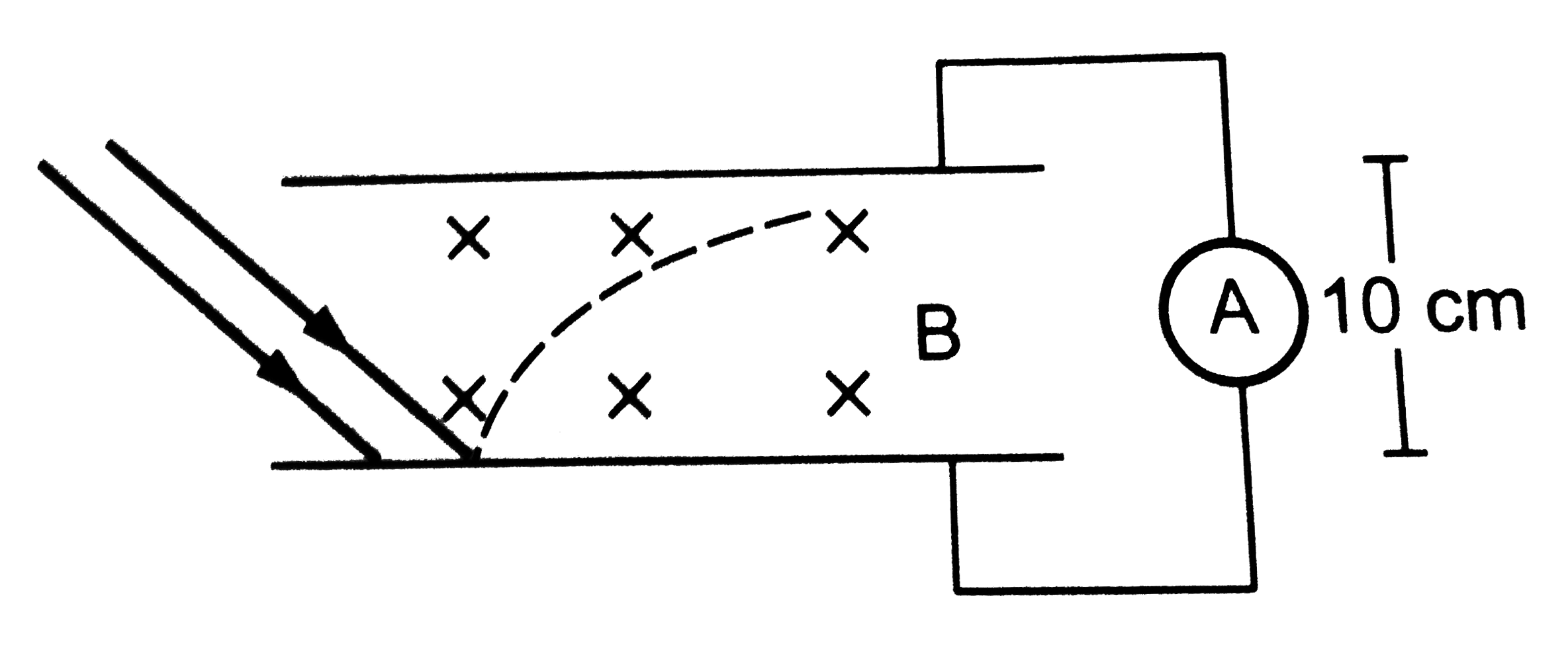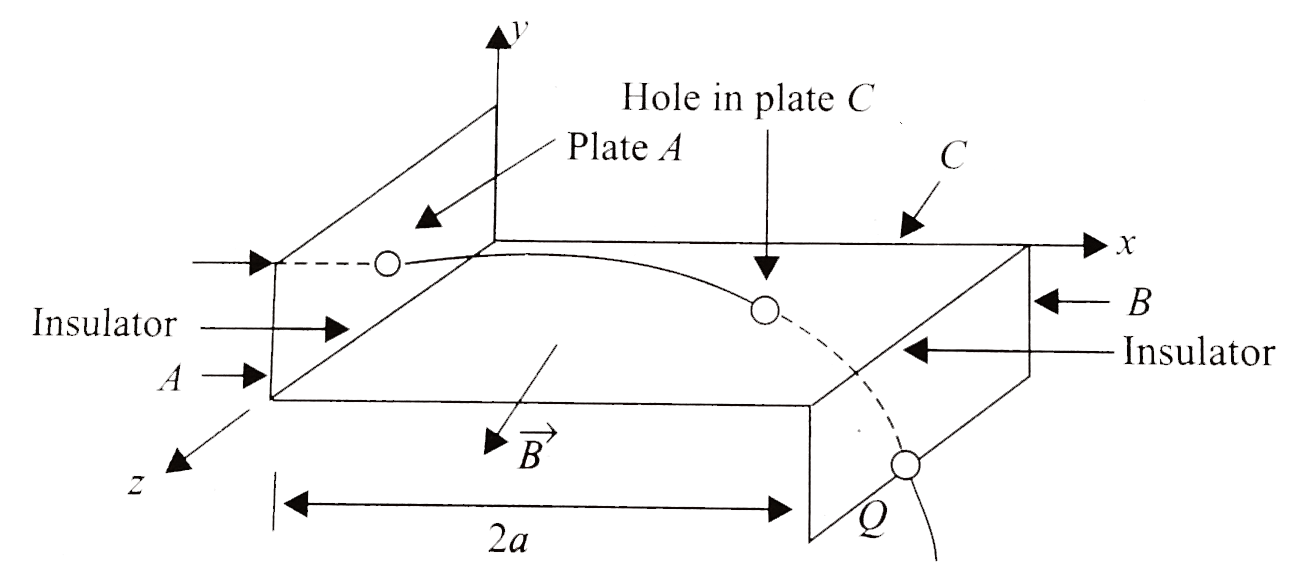The photo cathode and collector plate are kept 10 cm apart and connected through a galvanometer without a battery. A magnetic field B exists parallel to the plates. The work function of the emitter is 2.39 eV and the light incident on it has wavelength 400 to 600 nm. Find the minimum value of B so that galvanometer shows null deflection.

2.8×10−5T
2.8×10−4T
2.8×10−3T
2.8×10−2T
The correct Answer is:A
(KE)max=hf−ϕor(KE)max=3.1−2.39=0.71eV
r=mvqB
B=√2(KE)mq(sinceKE=12mv2)
B=√2(0.71×1.6×10−19)×9×10−311.6×10−19×0.1=2.8×19−5T
Similar Questions
In an experiment on photoelectric effect, the emitter and the collector plates are placed at a separation of 10cm and are connected through an ammeter without any cell.

A magnetic field B exists parallel to the plates. The work function of the emitter is 2.39 e V and the light incident on it has wavelengths between 400nm and 600nm. Find the minimum value of B for which the current registered by the ammeter is zero. Neglect any effect of space charge.View SolutionIn an experiment on photoelectric effect, the emitter and the collector plates are placed at a separation of 10cm and are connected through an ammeter without any cell. A magnetic field B exists parallel to the plates. The work function of the emitter is 2.39 e V and the light incident on it has wavelengths between 400nm and 600nm. Find the minimum value of B for which the current registered by the ammeter is zero. Neglect any effect of space charge.
 View Solution
View Solution
Knowledge Check
- Question 1 - Select One
Two metallic plates P(collector) and Q (emitter) are separated by a distance of 0.2 m. These are connected through an 0.2 m. These are connected through an ammeter without any cell. A magnetic field B exists parallel to the plates. Light of wavelengths between 2000 Å and 3000 Å fall of the plate Q whose work function is 2.22 eV.
The minimum value of B for which the current registered with ammeter is zero, isA3.8×10−5TB4.7×10−5TC6.7×10−5TD8.6×10−5T
In a photocell the plates P and Q have a separation of 5 cm, which are connected through a galvanometer without any cell. Bichromatic light of wavelengths 4000Å and 6000Å are incidenton plate Q whose work- functionis 2.39 eV. If a uniform magnetic field B exists parallel to the plates, find the minimum value of B for which the galvanometer shows zero deflection.
View SolutionIn a photocell the plates P and Q have a separation of 5 cm, which are connected through a galvanometer without any cell. Bichromatic light of wavelengths 4000Å and 6000Å are incidenton plate Q whose work- functionis 2.39 eV. If a uniform magnetic field B exists parallel to the plates, find the minimum value of B for which the galvanometer shows zero deflection.
View SolutionTwo metallic plates P (collector) and Q (emitter) are separated by a distance of 0.10 meter. These are connected through an ammeter without any cell. A magnetic field B exists parallel to the plates. Light of wavelength between 4000Åand6000Å fall on the plate whose work function is 2.39eV. Calculate the minimum value of B for which the current registered with ammeter is zero. Use, h=6.6×10−34Js,e=1.6×10−19C
View SolutionA metal plate has work function of 6eV. Light of wavelength 200nm falls on the plate. Photoelectrons are emitted in all possible directions. A magnetic field of 1T exists parallel to the plate as shown. What can be the maximum possible distance (in μm ) (in direction perpendicular to plate) from the plate surface reached by emitted photoelectrons? (Take mass of electron, me=9×10−31kg ).
'(##CEN_KSR_PHY_JEE_CO28_E01_031_Q04##)'View SolutionA beam of 450 nm light is incident on a metal having work function 2.0 eV and placed in a magnetic field B. The most energetic electrons emitted perpendicular to the field are bent in circular arcs of radius 20 cm. Find the value of B.
View SolutionA beam of 450 nm light is incident on a metal having work function 2.0 eV and placed in a magnetic field B. The most energetic electrons emitted perpendicular to the field are bent in circular arcs of radius 20 cm. Find the value of B.
View SolutionTwo recangular plates A and B placed at a distance 2a apart, are connected to a battery to produce an electric field. There are insulators between plantes C and other two plates. A magnetic field exists along z-axis. A charged particle of mass m and charge q passes through a hole at the middle of the plate A with velocity v and strikes at Q which is the middle of the bottom edge of plate B after passing through a hole inplate C. If E=mv2/qa, what will be the speed of the particle at Q?
 View Solution
View Solution

